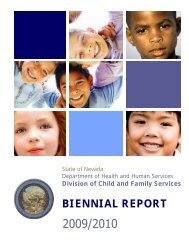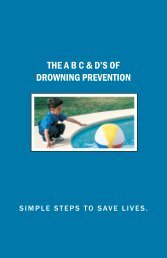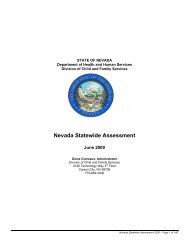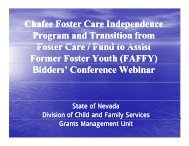Nevada Child & Family Services Statewide Newsletter - Division of ...
Nevada Child & Family Services Statewide Newsletter - Division of ...
Nevada Child & Family Services Statewide Newsletter - Division of ...
- No tags were found...
Create successful ePaper yourself
Turn your PDF publications into a flip-book with our unique Google optimized e-Paper software.
NEVADA RECEIVES HIGH GRADE FORPUBLIC DISCLOSUREOver the past several years, DCFS in partnership with the Department <strong>of</strong> Health and Human<strong>Services</strong>, the Governor’s Office, Legislature, county child welfare agencies, and children’sadvocates has made substantial progress in the area <strong>of</strong> public disclosure <strong>of</strong> findings<strong>of</strong> information about child abuse or neglect which resulted in a child fatality or near fatality.Recently, the “State Secrecy and <strong>Child</strong> Deaths in the US” survey, a joint report <strong>of</strong> the<strong>Child</strong>ren’s Advocacy Institute and First Star, published the results <strong>of</strong> a survey <strong>of</strong> publicdisclosure practices about child abuse or neglect fatalities or near fatalities with state rankings.<strong>Nevada</strong> and New Hampshire were the only two states to earn an “A”.To view the entire report, link to:http://www.firststar.org/news/report/report.aspUNITY TIPS & TRICKS -WHEN T0 USE -DeAnn DickinsonCase Directory Report – Let’s say you want a list <strong>of</strong> all the Cases assigned to you and/or a Staffmember. From the File menu on Case Directory (CFS056), a report can be generated displaying allcases in alphabetical order, with Case Numbers, Primary Indicator, Open and Assigned Date, CaseStatus and the Hearing Date. Tip: Use Find Case to filter and pull up either Open Case or Pending Closure cases then generatea report. Trick: Use Find Case to filter and pull up cases within a certain time frame in conjunction witha specific “Program”. Trick: Use Find Case to pull up a case by using only a Docket Number (works only if thedocket number has been recorded (see next topic).Court Case Numbers – Yes, you can record Court Case Numbers pertaining to individuals and/orthe particular case (District Court, Justice Court, Municipal Court, Juvenile Court and the <strong>Nevada</strong>Supreme Court).Tip: Use this window to record <strong>Nevada</strong> and/or other State Court information.Trick: Record it once and you’ll never have to type it again into your Court Report becausethere is a feature <strong>of</strong>f <strong>of</strong> the Case Document Directory window that allows you to select the appropriateCourt and/or Docket Number (CONTINUED ON PAGE 3)2
LAUDATIO auf Peter LohmeyerWassilios FthenakisMeine sehr verehrten Damen und Herren,ich spreche zu Ihnen als Präsident des Didacta Verbandes undzugleich in engster Kooperation mit meinem Kollegen, dem Vorsitzendendes VdS Bildungsmedien, Herrn Diepgrond. Es ist füruns eine besondere Freude, die „didacta – die Bildungsmesse2007“ unter das Motto Bildung als öffentliche Pflichtaufgabegestellt zu haben. Die logische Konsequenz daraus ist, es nicht nurzu behaupten, sondern auch etwas zu tun, damit diese Pflichtaufgabein der Öffentlichkeit präsent ist. Deshalb haben sichbeide Verbände auf Initiative des VdS Bildungsmedien entschlossen,zwei Bildungsbotschafter zu ernennen, und wir tun das mitgroßer Freude, weil wir zwei Persönlichkeiten finden konnten,die mit besonderer Hingabe, mit viel Energie und Engagementsich der Bildung verpflichtet fühlen und verpflichtet haben.Wenn ich heute die besondere Ehre habe, Peter Lohmeyer auszuzeichnen,dann möchte ich Ihnen dies sehr gerne begründen.Peter Lohmeyer hat diesen Titel bereits durch eine viel höherepolitisch-administrative Instanz verliehen bekommen, nämlichim Jahre 2005 vom Bundesministerium für Bildung und Forschung.Wir wollten nun dieses Amt nicht lediglich auf unsererEbene erneuern oder ihm einen weiteren Botschafterpostenverleihen. Wir ehren ihn vielmehr deshalb, weil er thematischeAkzente gesetzt hat, die Bestandteil moderner Bildung sind.In der Bundesrepublik sind 20 Prozent der Familien binationaleFamilien. Die kulturelle Diversität in diesem Land hat bereitsein Ausmaß angenommen, das unsere Bildungsaufmerksamkeitlängst auf sich hätte lenken müssen. Infolgedessen ist es notwendig,unsere Konzepte über die Bildung von Kindern im Umgangmit kultureller Diversität zu reflektieren und aus meinerSicht sogar zu verändern. Die Bundesrepublik hat in der Vergangenheitein Bildungsverständnis entwickelt, das mit der angesprochenenkulturellen Diversität nicht umzugehen versteht.Das kulturell Fremde und Andersartige wird eher beseitigt, eliminiertstatt systematisch genutzt, um Lerneffekte für die Kinderund kulturellen Gewinn für die Öffentlichkeit daraus abzuleiten.Es ist das Verdienst von Herrn Peter Lohmeyer, sich öffentlichdafür ausgesprochen zu haben, die kulturellen Aspekte stärkerin die Bildungspläne, stärker in die konkrete Arbeit mit denKindern vor allem in Ganztagsschulen zu integrieren und diesesystematisch für mehr individuellen Lerngewinn zu nutzen.Aber ich möchte noch einen weiteren Aspekt hervorheben, dermir besonders wichtig erscheint: Das Engagement dieses Künstlersrichtet sich nämlich nicht nur nach außen, es ist genausostark ausgeprägt, was das Innenleben seiner Familie betrifft.Siealle wissen, dass ich in der Bundesrepublik die Vaterforschunginitiiert und eine große Studie geleitet habe, die repräsentativuntersucht hat, wie Vaterschaft sich in diesem Land entwickeltund konkretisiert. Ich könnte sagen, dass Peter Lohmeyer denPrototypen meines Forschungsbefunds verkörpert, denn 67 Prozentder Väter konzeptualisieren sich nicht mehr als Brotverdiener,sondern als Erzieher ihrer Kinder. Diese sanfte Revolutionin den Köpfen findet bislang in der Bundesrepublik keineUmsetzung im täglichen Leben. Denn die Gesellschaft in derBundesrepublik ist so hochgradig effizient organisiert, dass dieUmsetzung solcher an sich wünschenswerten Konzepte effizientverhindert wird.Meine Damen und Herren, die beiden genannten Aspekte bietenAnlass genug, um diesen Künstler zu ehren. Einen Künstler,der sich in seiner Familie engagiert und in der Öffentlichkeit fürmehr Bildung für alle Kinder eintritt. Ich freue mich, und es istfür den Verband und für mich persönlich eine besondere Ehre,Ihnen heute diese Urkunde überreichen zu dürfen.Ich danke Ihnen.Wassilios Fthenakis, Pr<strong>of</strong>essor Dr. mult., geb. 1937. Studium derPädagogik (Griechenland), Anthropologie und Humangenetik, Molekulargenetikund Psychologie (LMU München). 1975-2006 Direktordes Staatsinstituts für Frühpädagogik in München, 1987-2002 Pr<strong>of</strong>essorfür angewandte Entwicklungspsychologie und Familienforschungin Augsburg, seit 2002 ordentlicher Pr<strong>of</strong>essor für Entwicklungspsychologieund Anthropologie an der FU Bozen, Berater vielerInstitute, Experte für Frühpädagogik und Familienforschung inDeutschland sowie Initiator der neueren Bildungspläne.PreisgeldempfängerDie Max-Brauer-Schule in Hamburg besuchen etwa1200 Schüler aus über 30 Nationen. Seit 20 Jahren lernendie Grundschüler in einem ihnen gemäßen Lerntempo.Die älteren Schüler wählen in der Pr<strong>of</strong>iloberstufenicht mehr einzelne Kurse, sondern Fächerpaketewie z. B. „Sprache und Kultur“. Im Ganztagsunterrichtmacht die Schule über 40 Angebote, von Cheerleading,Web-Design, Flugzeugmodellbau bis Gebärdensprache.Dieses außerordentlich vielfältige Angebot wird auchdurch das besondere Engagement der Eltern und desFördervereins der Schule ermöglicht. Die selbstverantworteteSchule wurde bereits 1998 als „Umweltschule inEuropa“ und 2006 mit dem „Deutschen Schulpreis“ ausgezeichnet.www.maxbrauerschule.de160
CALIENTE YOUTH CENTER ~CAPITAL IMPROVEMENTS - Jamie KillianCapital Improvement Projects (CIP) for the CalienteYouth Center (CYC) that were funded in1999, 2001 and 2003 are finally nearing completion.The CIP projects consist <strong>of</strong> upgrades to sevenyouth living units including replacing existingHeating, Ventilation and Air Conditioning (HVAC)systems, plumbing renovations, and the design andcomplete installation <strong>of</strong> sprinkler and fire alarm systems. The Americans with Disabilities Act(ADA) retr<strong>of</strong>its are also being completed as required. Other projects include the construction<strong>of</strong> a new recreation building and renovations to the existing swimming pool. Inflationarycosts required the projects to be completed in two phases in order for additional funding to beapproved and appropriated.Unable to lure potential contractors to separately bid and complete the total <strong>of</strong> five projects forthe initial funded amount in the rural location, the State <strong>of</strong> <strong>Nevada</strong> Public Works Board(SPWB) utilized a new program to realize construction start up in February 2007. All <strong>of</strong> theprojects were assigned to a Construction Manager at Risk allowing the projects to be combinedand all work to be coordinated by one contractor.Construction Management at Risk (CMAR) involves hiring a firm to manage a constructionproject for a flat fee. The construction manager then bids the construction to subcontractors,submits a guaranteed maximum price to the client, provides a bond and builds the project.The hired construction management contractor then works closely with SPWB as well as theclient to insure that projects are completed in an economicallyfeasible method, working objectively in the client’s interest.At CYC, the CMAR method has proven to be effective. SPWBProject Manager II Architect, Kaye Burlison, who was assignedthe CYC project during Phase II in August 2007, has diligently,pr<strong>of</strong>essionally and expertly collaborated with our constructionmanagement firm, Mountain Vista Development Inc. (MVDI) tosee the projects through to completion. Communication betweenall entities inclusive <strong>of</strong> CYC has been open and productivewith meetings held every other week, including all subcontractorsto discuss progress and identify and resolve issues <strong>of</strong>concern. Both Burlison and MVDI recognize and appreciate themission <strong>of</strong> CYC and construction has been completed with effortsmade to minimally impact operation <strong>of</strong> the youth center.5
FOSTER CARE FACTSTotal Population:5,490 children were in the foster care system in <strong>Nevada</strong> on January 1, 2008.Most children are placed temporarily in foster care due to parental abuse or neglect.Age: Average Age: 6.5 years 6% >1 year 19% 11-15 years 39% 1-5 years 11% 16-18 years 24% 6-10 years 1% >19 yearsGender: Male: 51% Female: 49%Race and Ethnicity: In out-<strong>of</strong>-home care In state child populationBlack (non-Hispanic) 22% 8%White (non-Hispanic) 56% 54%Hispanic 17% 29%Am. Indian/Alaska Native (non-Hispanic) 1% 1%Asian/Pacific Islander (non-Hispanic) 1% 14%Unknown
NEVADA YOUTH ADVISORY BOARD—NEVADA LIFE - Emma ByrdThe <strong>Nevada</strong> Youth Advisory Board, <strong>Nevada</strong> Life, is a statewide organizationmade up <strong>of</strong> young people between the ages <strong>of</strong> 15 and 21 whohave experienced foster care. The Youth Advisory Board (YAB) operatesunder the direction <strong>of</strong> the Independent Living Program that assistsfoster and former foster youth to make the transition to adulthood. Withthe technical assistance <strong>of</strong> the National Resource Center for the Development <strong>of</strong> Youth, YAB wascreated to give these youth a voice in matters relating to foster care policies that impact them. YABexists to provide exemplary leadership and empowerment opportunities for youth who have or willexperience out <strong>of</strong> home care. It is a knowledgeable statewide voice aimed at influencing social policiesand practices that affect all foster and former foster care youth.YAB is made up <strong>of</strong> twelve representatives from the child welfare jurisdictions and the Tribes. YAB<strong>of</strong>ficers include the president, vice-president and secretary. The board operates under the guidelines<strong>of</strong> its mission statement and by-laws. YAB meets face-to-face twice a year at locations throughoutthe State and conducts quarterly video-conference meetings. Meetings have been held in Elko, CarsonCity, Las Vegas, and Reno. YAB goals for 2008 include developing a network system to reachand involve other foster youths through published communications such as newsletters and brochures;participate in leadership training opportunities; monitor and track legislation relating to fostercare and prepare to provide comments as necessary.On April 25-26, 2008, DCFS’ District Office in Carson City hosted this year’s first face-to-faceYAB meeting . The two-day event consisted <strong>of</strong> the business meeting, social and recreational activities.Hallie Kirk, Social Worker III, played an instrumental role in coordinating, planning and organizingthe activity schedule for this event that included a grand tour <strong>of</strong> the <strong>Nevada</strong> State LegislatureBuilding, a relaxing evening at Comma C<strong>of</strong>fee listening to Celtic music, and <strong>of</strong> course some learningtook place too. Wells Fargo Bank conducted a workshop onbanking and finance management. Additionally, Mario Auto providedinformation on how to buy a used car and tips on what to lookfor. Both workshops were well received by all. The meeting wasvery productive, knowledge based and fun filled. Ms. Kirk and theDCFS staff provided the food and refreshments for the group. TheFirst Presbyterian Church <strong>of</strong> Carson City furnished housing and recreationalactivities for the youth. Overall, this was a very productivemeeting thanks to the efforts <strong>of</strong> Pat Hedgecoth, managers, staff andHallie for their invaluable support and contributions.FUTURE PROJECT SYouth ConferencesNew Web Page forFoster YouthEducation and Job FairsCommunity Service Projects7
NORTHERN NEVADA CHILD AND ADOLESCENTSERVICES CELEBRATES 30 YEARS OFSERVICE—Jane GriffenNorthern <strong>Nevada</strong> <strong>Child</strong> and Adolescent <strong>Services</strong> (NNCAS), more commonly known in thecommunity as <strong>Child</strong>ren’s Behavioral <strong>Services</strong> (CBS), marked the occasion <strong>of</strong> its thirtieth anniversary<strong>of</strong> the dedication <strong>of</strong> the Enterprise Road location in February, 2008.The Honorable Mike O’Callaghan, Governor <strong>of</strong> the State <strong>of</strong> <strong>Nevada</strong>, presided over the dedicationceremony on February 9, 1978. Distinguished guests (noted herein by their title at thetime) included Mr. Michael Melner, Director, Department <strong>of</strong> Human Resources; Mr. WilliamJ. Mayville, Director, <strong>Child</strong>ren’s Behavioral <strong>Services</strong>, Washoe; Rabbi Abraham Feinberg; Mr.Marvin Picollo, Superintendent, Washoe County School District; Mr. Jerome Blankinship,Advisory Board Member, Mental Hygiene and Mental Retardation; Mr. Frank Sullivan, ChiefProbation Officer, Juvenile Parole; Assemblywoman Peggy Westall; Ms. Mary Gojack; StateSenator Richard H. Bryan; Ms. Nancy Gomes; Ms. Alyce Taylor; Mr. Marvin Moss; Mr. BudL. Beasley and many other fine representatives from communities and programs around thestate.Mr. Mike Melner recently wrote memories about this long-ago event with such clarity and interest.A portion <strong>of</strong> his letter states:“I was newly appointed director <strong>of</strong> Human Resources at the time, and when the Governorasked me to prepare comments, my reaction was such that he accused me <strong>of</strong> being a ‘humanservices junkie’ (which I think was a compliment).The building is dedicated to the memory <strong>of</strong> Dr. Sidney Tillim, the first post-war director <strong>of</strong>mental health in <strong>Nevada</strong>, and the one who brought us into the modern age <strong>of</strong> mental healthservices. My involvement was to attempt to substitute new buildings for the old facilities andto adjust programs in such a way as to rid <strong>Nevada</strong> <strong>of</strong> primitive buildings and primitive programs.In the excitement over the new building, however, I tried to remind everyone that it is peoplewho make programs, not buildings, and that the success <strong>of</strong> your program to this day has beenone <strong>of</strong> people. Those <strong>of</strong> us who remember Dr. Tillim, know he would have been proud at theway people have used and responded to all his programs.”NNCAS is proud to acknowledge the people on whose shoulders our work rests, and to carryforward the bright future <strong>of</strong> services to the children and families <strong>of</strong> Northern <strong>Nevada</strong>.8
SOUTHERN NEVADA CHILD ANDADOLESCENT SERVICES STAFF HOST VISITBY BRITISH COLUMBIANS - Fran McClainThis past April 7 and 8, 2008 Fran McClain, Southern <strong>Nevada</strong> <strong>Child</strong> and Adolescent <strong>Services</strong>(SNCAS) Clinical Program Manager II, and her staff hosted five visitors from School District 36 inSurrey, British Columbia. The purpose <strong>of</strong> the visit was to learn about the Wraparound processsince the visitors hope to start similar wraparound work in their community. Surrey is the largestschool district in British Columbia. Included in the group was their Manager for Safe Schools, twoSociologists from the local university, a Canadian Mounted Police staff and their Youth DiversityLiaison.The group toured the East, West and North Las Vegas Neighborhood <strong>Family</strong> Service Centers andalso spent time discussing the process with DCFS Wraparound in <strong>Nevada</strong> (WIN) Psychiatric Caseworkers(David Taylor, Carly Aldis, Salvi Martinez, Keyshera Kirk, Raquel Rezentes), Supervisors(Barbara Lewis, Christina Mashburn, Elysia Stockton, Susanne Smith), Clinical Program Managers(Lisa Wetzel, Nancy Sirkin, Susie Miller, Karen Chandler and Psychologist Randy Stiles), and <strong>Nevada</strong>Parents Encouraging Parents (PEP) management staff (T.J. Rosenberg). Patty Merrifield,Deputy Administrator for <strong>Child</strong>ren’s Mental Health, joined the group at lunch to continue the discussion.The British Columbians were extremely interested in how DCFS started the WIN process, identifiedcore values and developed partnerships with other agencies, parents, and informal supports.The group was able to ask questions, and staff shared strategies including how best to engage families,including use <strong>of</strong> the Strengths, Needs, and Cultural Discovery Targeted Case Management Assessment.Staff reviewed the process <strong>of</strong> developing and sustaining <strong>Child</strong> and <strong>Family</strong> Teams andshared success stories. The enhanced communication and teaming between DCFS staff and thevisitors was highly successful. DCFS staff stepped up to assist colleagues with knowledge-sharingand made the trip to <strong>Nevada</strong> well worthwhile.An old axiom states that in order to keep what you have, you must give it away. Fran was veryproud <strong>of</strong> her staff in <strong>Child</strong>ren’s Clinical <strong>Services</strong>, Wraparound in <strong>Nevada</strong>, and the On CampusTreatment Homes, who hold these values in high regard every day. We wish our friends in BritishColumbia much success in their development <strong>of</strong> a Wraparound Process.Southern <strong>Nevada</strong> <strong>Child</strong> and Adolescent <strong>Services</strong> (SNCAS)Main Campus6171 W. Charleston Blvd., Bldg. 8Las Vegas, NV 89146Phone: (702) 486-6120Web-Site : www.dcfs.state.nv.us/DCFS_CommunityBasedOPSvcs.htmFax: (702) 486-77429
WCDSS CELEBRATES WITH ICE CREAM -Otto LynnWashoe County Department <strong>of</strong> Social <strong>Services</strong> (WCDSS) celebrated improved federal outcomes reportingwith balloons and ice cream socials during the month <strong>of</strong> April. Mike Capello, Director,stated, “the ice cream socials were a small way to show staff we recognized their hard work and efforts.”In addition, workers were awarded an extra coveted “jean day”. Recognition <strong>of</strong> improvedoutcomes included a series <strong>of</strong> three bulletins that explained more thoroughly WCDSS performance inrelation to the federal child welfare outcomes. Frequently federal outcomes, benchmarks and measuresare referenced without enough background on how individuals directly impact the performancerating WCDSS receives. So while celebrating the success, WCDSS took time to describe in moredetail how each worker impacts the federal measures.Recurrence <strong>of</strong> Abuse or NeglectThis measure is the percentage <strong>of</strong> children who had a substantiated allegation <strong>of</strong> abuse or neglectwithin six months <strong>of</strong> a prior substantiated allegation <strong>of</strong> abuse or neglect. The underlying issue here isdoes WCDSS provide services that are effective in keeping children safe following a substantiatedincident for at least six months? This is a reflection <strong>of</strong> the quality <strong>of</strong> case work and support servicesworkers provide families.The federal standard allows child welfare agencies to have no more than 6.1% <strong>of</strong> cases in whichthere is an additional substantiated incident within six months.In March WCDSS was in compliance with a percentage <strong>of</strong> 5.9%.Abuse in CareThis measure is the percentage <strong>of</strong> children in foster care who were determined to be abused or neglectedby a foster parent or facility staff. <strong>Child</strong> welfare agencies are charged with a very high level<strong>of</strong> responsibility to keep children safe while in out <strong>of</strong> home care. This measure demonstrates thequality <strong>of</strong> our foster homes, shelter and other facilities in which we place children and the fact thechildren are safe while in our care. A second key factor that impacts this measure is the frequency <strong>of</strong>case worker visits to the foster home or placement.The federal standard allows no more than 0.57% <strong>of</strong> children placed in out <strong>of</strong> home care to be abusedor neglected. In other words, <strong>of</strong> the 800 children in out <strong>of</strong> home care in Washoe County no morethan four substantiated incidents <strong>of</strong> abuse or neglect have occurred. This is a high standard and onlya few incidents can result in non compliance.In March WCDSS was in compliance with a percentage <strong>of</strong> 0.50%.(CONTINUED ON PAGE 11)10
(WCDSS CONTINUED FROM PAGE 10)Placement StabilityThis measure is the percentage <strong>of</strong> children who have been in foster care less than 12 months fromthe time <strong>of</strong> the latest removal, who have had no more than two placement settings. Placement stabilityaddresses the child’s well being and the ability <strong>of</strong> the child welfare agency to lessen the stress<strong>of</strong> moving to a new home for the children. Research indicates that if the child is moved severaltimes it is very difficult for them to trust and form attachments to others.The federal standard expects child welfare agencies to have more than 86.7% <strong>of</strong> children in care forless than 12 months and that these children will have no more than two placement settings.In March WCDSS had a percentage <strong>of</strong> 77.8%. Although this percentage does not currentlymeet the national standard, WCDSS has demonstrated an upward trend <strong>of</strong> this measure.The state average is 68%.ReunificationThis measure is the percentage <strong>of</strong> children who exited foster care and returned to their parents inless than 12 months from the time <strong>of</strong> their latest removal from home. As families make progress towardreunification, it is important for caseworkers to assess the family’s strengths and needs in atimely manner to determine when it is safe and appropriate to return a child home.The federal standard expects that <strong>of</strong> all children returned to their parents, 76.2% <strong>of</strong> them should bereturned within 12 months.In March WCDSS was in compliance with a percentage <strong>of</strong> 81%.ReentryThis measure is the percentage <strong>of</strong> children entering foster care who have re-entered care within 12months <strong>of</strong> a prior foster care episode. The underlying issue here is does the child welfare agencyprovide services to the family so children return home safely for 12 months following dismissal <strong>of</strong>court custody?The federal standard allows up to 8.6% <strong>of</strong> children who exit foster care to come back into fostercare in the 12 months following their release. While many states experience an increase in this percentagewhen they are working on their reunification measure, WCDSS remains in compliance withthis measure while at the same time experiencing an increase in the reunification measure.(CONTINUED ON PAGE 12)11
(WCDSS CONTINUED FROM PAGE 11)Adoption PercentageThis measure is the percentage <strong>of</strong> children whose adoptions finalized in less than 24 months fromthe time <strong>of</strong> their latest removal from home.The federal standard expects that <strong>of</strong> all children adopted, more than 32% <strong>of</strong> the adoptions shouldbe finalized within 24 months <strong>of</strong> the child’s latest removal from home. To that end, identifyingand providing necessary services to the family as soon as possible after the child has been removedis critical. If the child is unable to return safely home and appropriate services have been provided,then the child welfare agency can move towards adoption. The adoption percentage looks atagency performance as it relates to the permanency timeframes set out in the Adoption and SafeFamilies Act <strong>of</strong> 1997 (ASFA).In March WCDSS had a percentage <strong>of</strong> 23.8%. Although WCDSS is not currently meetingthe national standard, trends indicate upward movement on this measure. The state averageis 21.6%.Adoption Median MonthsThis measure is the median length <strong>of</strong> time from the date <strong>of</strong> the child’s last removal from home tothe date the adoption is finalized. This measure provides the child welfare agencies another opportunityto review the length <strong>of</strong> time it may take to process an adoption. OK - try to remember backto your statistics course! The median is the middle length <strong>of</strong> time. For example, if five childrenwere adopted during a specific period <strong>of</strong> time and they stayed the following number <strong>of</strong> months incare:A) child 1 was in care for 7 monthsB) child 2 was in care for 18 monthsC) child 3 was in care for 30 monthsD) child 4 was in care for 65 monthsE) child 5 was in care for 78 monthsThen the median months in care would be 30 months.The federal standard expects that <strong>of</strong> all children adopted the median time in care should be lessthan 36 months.In March WCDSS was in compliance with a median <strong>of</strong> 30 months.12
CLARK COUNTY DEPARTMENT OFFAMILY SERVICES INTRODUCES FOSTER ONERECRUIT ONEClark County Department <strong>of</strong> <strong>Family</strong> <strong>Services</strong> (CCDFS) is very excited to introduce to its currentfoster and adoptive parents the Foster One Recruit One initiative in an effort to increase thenumber <strong>of</strong> foster families for Clark County children. Modeled after the classic Tupperware Party,the Foster One Recruit One initiative is an informal and fun way <strong>of</strong> introducing foster care andadoption to friends, family, neighbors and co-workers. Current foster or adoptive parents areasked to host an event in their homes and set the invite list, and as a token <strong>of</strong> our gratitude fortheir hospitality, a small gift is given to the hosts. From there, a CCDFS Foster RecruitmentSpecialist takes over, providing refreshments, fun and information for those on hand.For additional information about the program, please call Gina Shanks at (702) 455-4024.CHILD CARE CHAT— Nicole NicholAs a <strong>Child</strong> Care Development Surveyor, it is my job to ensure the health, safety, and well being<strong>of</strong> children. I have seen many positive affects that the child care facilities <strong>of</strong> <strong>Nevada</strong> have had onchildren. It is enlightening to see the bonds <strong>of</strong> trust being formed between provider and child,how providers become advocates for the children they care for, and observing the developmentalgrowth in children by achieving appropriate milestones with the guidance <strong>of</strong> their caregivers.There are many aspects <strong>of</strong> being a <strong>Child</strong> Care Development Surveyor that I find rewarding.When I walk through the doors <strong>of</strong> child care facilities, I am pleased to see that the programs arepromoting healthy growth, development and protection <strong>of</strong> children. It is my job to ensure that thechild care facilities that I survey meet the regulatory standards set forth by <strong>Nevada</strong> AdministrativeCode (NAC) 432A. I enjoy <strong>of</strong>fering the caregivers valuable resources and suggestions throughtechnical assistance and trainings. My involvement in the day to day operations <strong>of</strong> several <strong>of</strong> thechild care facilities has provided me with the opportunity to observe children learning valuablelessons through play and instruction. I find great satisfaction when I walk into a classroom andhear the laughter <strong>of</strong> children and see smiles on the faces <strong>of</strong> the caregivers. The alliance betweenthe caregivers and children constantly reminds me <strong>of</strong> how important our jobs are for achievingpositive outcomes for the children <strong>of</strong> <strong>Nevada</strong>.13
CLARK COUNTY HIRESOMBUDSMAN - Chrystal C. MainIn 2007, the Clark County Commission endorsed certain goals and objectives related toimproving child welfare services in Clark County. In conjunction with the adoption <strong>of</strong>these goals the Ombudsman role, with a focus on dispute resolution, was created.In January 2008, Tisa Evans was appointed as the Ombudsman and reports directly tothe County Manager’s Office. Tisa is primarily responsible for connecting stakeholderswith appropriate parties in Clark County Department <strong>of</strong> <strong>Family</strong> <strong>Services</strong> (CCDFS) to facilitateresolution <strong>of</strong> issues. Further, Tisa will focus on the development <strong>of</strong> polices andprocedures with respect to consumer/stakeholder concerns.Tisa is a person <strong>of</strong> great intellect and experience in child welfare. Immediately beforemoving to <strong>Nevada</strong>, she was the Director <strong>of</strong> Residential Treatment at the Keystone Centerin Pennsylvania, a mental health facility for children and youth. She holds a BachelorsDegree in Social Behavioral Sciences from Pennsylvania State University and a MastersDegree in Elementary Education from Cheyney University <strong>of</strong> Pennsylvania.How to contact the Ombudsman:Address:Tisa N. Evan, OmbudsmanDispute Resolution for <strong>Child</strong>renClark County Manager’s Office500 S. Grand Central Pkwy, 6th FloorLas Vegas, NV 89155Toll free phone: 1 (866) 780-9541Fax: (702) 455-3558Email: evanst@co.clark.nv.usWeb-site: www.accessclarkcounty.com/clark_county/Ombudsman/index.htm14
UPCOMING EVENTSFallon District Office <strong>of</strong> the <strong>Division</strong> <strong>of</strong> <strong>Child</strong> and <strong>Family</strong> <strong>Services</strong>The Annual Foster Parent Appreciation Picnic will be held on June21, 2008. This year the Churchill County Parks and Recreation donatedthe use <strong>of</strong> the indoor pool for the foster parents and families.There will be food, drinks, sno-cones, bounce house and swimming.Come out and join the fun!!!!In <strong>Nevada</strong>, mandatory reporters <strong>of</strong> childabuse and neglect include:Social workersSchool personnelMedical pr<strong>of</strong>essionals and health careworkersMental health pr<strong>of</strong>essionals<strong>Child</strong> care providersMedical examiners and coronersON LINE TRAININGCourts, district attorneys, and law enforcement <strong>of</strong>ficersMembers <strong>of</strong> the clergyDCFS has created an online class for mandatoryreporters <strong>of</strong> child abuse and neglect to use as aguide for when and how to report such cases tothe proper authorities.The online class, which can be viewed and completedat www.nvpartnership4training.com, providesa straightforward, engaging, and convenientway <strong>of</strong> learning the basics about <strong>Nevada</strong>’sMandatory <strong>Child</strong> Abuse and Neglect ReportingLaw.You may also review a variety <strong>of</strong> on line courses<strong>of</strong>fered by <strong>Nevada</strong> Partnership for Training.15
















